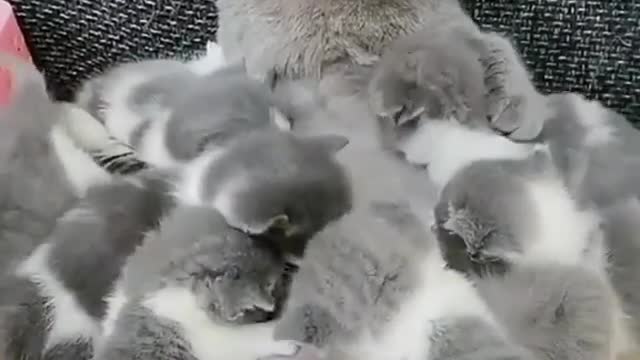Premium Only Content

Mother cat with his babies
Like dogs, cats look very different from people but share many of our body’s characteristics, such as a circulatory system, lungs, a digestive tract, a nervous system, and so on Breeds and Body Size
There are many different breeds of cats, including Abyssinian, Himalayan, Maine Coon, Manx, Persian, Scottish Fold, and Siamese, to name a few. The Cat Fanciers’ Association, which is the world’s largest registry of pedigreed cats, recognizes about 40 distinct breeds. The most familiar cats are the domestic shorthair and the domestic longhair, which are really mixtures of different breeds. Cat breeds differ in looks, coat length, and other characteristics but vary relatively little in size. On average, only 5 to 10 pounds separate the smallest and largest domestic breeds of cats. Cats also share the rapid metabolism that dogs have, which results in a higher heart rate, respiratory rate, and temperature than those of people (see Table: Normal Feline Physiologic Values ). Cats generally live longer than dogs, and many live to be 20 years old or older. Cats are better at conserving heat than at cooling themselves, although their small size relative to their large surface area makes for more effective cooling than in dogs. Cats lose heat through external radiation. They have some sweat glands that aid in evaporative cooling, and licking their fur further improves this process. Heat is also lost through panting, although this is not as effective a method of cooling as it is in dogs. Cats typically also seek dark, cool places to shelter themselves from the heat of the day. As with all animals, cats should never be shut in cars or other hot, confined spaces. This can lead to heat stroke and death
Cats have keen vision; they can see much more detail than dogs. Concentrated in the center of the retina of the eye, a specific type of cell called a cone gives cats excellent visual acuity and binocular vision. This allows them to judge speed and distance very well, an ability that helped them survive as hunters. However, although the cone cells are also responsible for color vision, it is uncertain whether cats can see colors. Like dogs, cats also have a lot of the retinal cells called rods, which are good at collecting dim light. In fact, cats can see 6 times better in dim light than people, giving rise to the myth that cats can see in the dark. Cats also have a reflective layer called the tapetum lucidum, which magnifies incoming light and lends a characteristic blue or greenish glint to their eyes at night.
A unique feature of both canine and feline eyes is the nictitating membrane, which is also called the third eyelid. This additional eyelid is a whitish pink color and is found under the other eyelids in the inside corner (near the nose) of the eye. The third eyelid extends up when needed to protect the eyeball from scratches (such as while traveling through brush) or in response to inflammation
-
 27:56
27:56
ArturRehi
4 hours agoPutin Betrayed Iran - Israel’s AIR FORCE CONTROL THE SKIES | Ukraine Update
29 -
 DVR
DVR
RalliedLIVE
3 hours ago $2.40 earned24 HOUR BIRTHDAY STREAM
15.9K3 -
 20:38
20:38
Producer Michael
20 hours agoAmazing Luxury Discoveries On The Las Vegas Strip
51.3K3 -
 8:48
8:48
Faith Frontline
13 hours agoThe Moment That Shattered Dave Smith’s Atheist Beliefs
18K7 -
 2:39:17
2:39:17
Side Scrollers Podcast
18 hours agoKing of the Couch 2025: WHO WILL TAKE THE CROWN?!
70.9K3 -
 10:58
10:58
MattMorseTV
20 hours ago $5.97 earnedLindsey Graham just got EXPOSED.
28.9K77 -
 2:03:05
2:03:05
BEK TV
1 day agoTrent Loos in the Morning 6/19/2025
25.2K -
 3:19
3:19
Rena Malik, M.D.
1 day ago $1.89 earnedUrologist explains why you pee more often in the winter
24.8K9 -
 19:30
19:30
Ohio State Football and Recruiting at Buckeye Huddle
3 days agoOhio State Football: Which Playoff Format Would be the Best for the Buckeyes?
23.6K2 -
 36:25
36:25
Esports Awards
19 hours agoLaunders on CS2, Esports Evolution & Staying Real in the Game | Origins Podcast #12
32K1